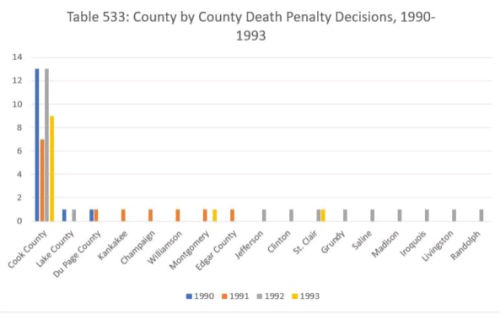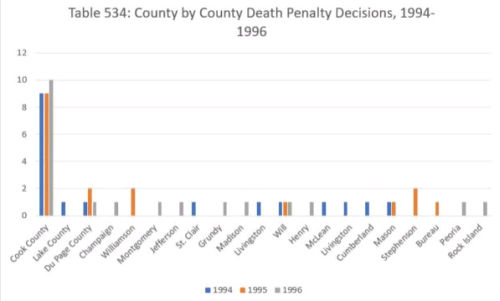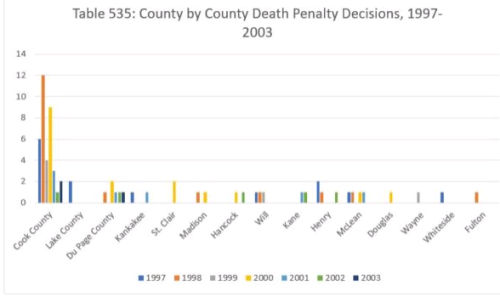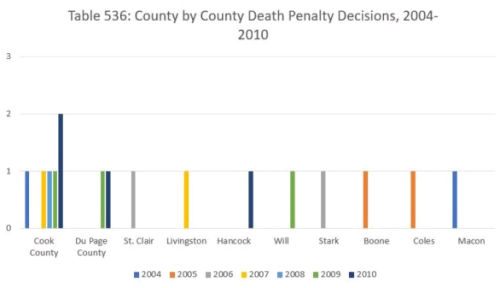This week, we continue our parallel look at automatic death penalty appeals here and over at our sister blog, the California Supreme Court Review. Last week, we reviewed the Illinois Supreme Court's year-by-year caseload from 1990 until the death penalty was abolished in this state. This week, we're going to take a look at where the cases came from, and determine whether death judgments from any particular county had a noticeably lower (or higher) affirmance rate than judgments from elsewhere.
In Table 533, we report the data for the years 1990 through 1993. Cook County is far and away the largest single source of death penalty judgments each year. In 1990, the Court decided thirteen death penalty cases from Cook County. The Court decided one case from Lake County and one from Du Page.
In 1991, the Court decided seven death penalty appeals from Cook County. The Court decided one case apiece from Du Page, Kankakee, Champaign, Williamson, Montgomery and Edgar counties. In 1992, the Court decided thirteen death cases from Cook County. The court heard one case each from Lake, Jefferson, Clinton, St. Clair, Grundy, Saline, Madison, Iroquois, Livingston and Randolph counties. In 1993, the Court decided nine death cases from Cook County. The Court also decided one case each from Montgomery, St. Clair, Macoupin and Winnebago counties.

We report the year-by-year data for the years 1994 through 1996 in Table 533. In 1994, the Court heard nine death penalty appeals from Cook County, two from Livingston County, and one each from Lake, Du Page, St. Clair, Will, McLean, Cumberland and Mason counties. In 1995, the Court decided nine death penalty appeals, two each from Du Page, Stephenson and Williamson counties, and one apiece from Will, Mason and Bureau counties. In 1996, the Court decided ten death penalty appeals from Cook County, and one case each from Du Page, Champaign, Montgomery, Jefferson, Grundy, Madison, Will, Henry, Peoria and Rock Island counties.

In 1997, the Court decided six death penalty cases from Cook County, two cases each from Lake and Henry counties, and one each from Kankakee, Will, McLean and Whiteside counties. In 1998, the Court decided a dozen death penalty cases from Cook County and one case each from Du Page, Madison, Will, Henry, McLean and Fulton counties. In 1999, the Court decided only four death penalty appeals from Cook County. The court heard one case each from Will and Wayne counties. In 2000, the Court decided nine death penalty cases from Cook County, two cases each from Du Page and St. Clair counties, and one case each from Madison, Hancock, McLean and Douglas counties. In 2001, the Court decided three death penalty appeals from Cook County and one case each from Du Page, Kankakee, Kane and McLean counties. In 2002, the Court decided only one death penalty appeal from Cook County, and one each from Du Page, Hancock, Kane and Henry counties. The following year, the Court decided two death penalty appeals from Cook County and one from Du Page County.

The Court decided only two death penalty appeals each year from 2004 through 2007. In 2004, the Court decided one case each in Cook and Macon County. In 2005, the Court decided one case each from Boone and Coles counties. In 2006, the Court decided one case each from St. Clair and Stark counties. In 2007, the Court decided one death penalty appeal from Cook County, and one from Livingston county. In 2008, the Court's only death penalty case originated in Cook County. In 2009, the Court decided three mandatory death penalty appeals – one each from Cook, Du Page and Will counties. In 2010, the Court decided two death penalty cases from Cook County, one from Du Page county and one from Hancock county.

Join us back here tomorrow as we continue our review of the Court's death penalty appeals.
The content of this article is intended to provide a general guide to the subject matter. Specialist advice should be sought about your specific circumstances.

